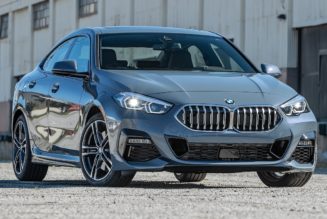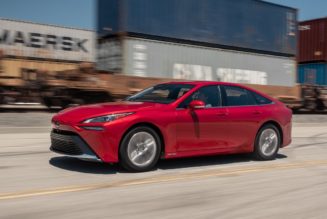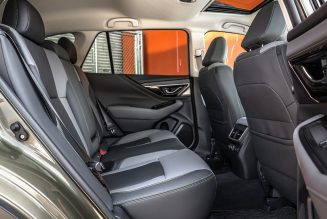We’ve been living with the 2020 BMW 2 Series Gran Coupe for nearly half a year now, and the pint-sized sedan has been put through our daily routines and spontaneous adventures. While the 228i Gran Coupe was out on a road trip, I spent time with one of its platform siblings, the X1, to answer a frequently asked question today’s car shopper might have: What do you gain and give up by switching to an SUV?
BMW X1 or BMW 2 Series Gran Coupe: How Practical?
For a small sedan with a swoopy roofline, the BMW 228i Gran Coupe is practical for a single person or a couple. The 15.1-cubic-foot trunk easily accommodates a week’s worth of groceries and a couple medium-sized pieces of luggage. However, you need to fold the 40/20/40 split-folding rear seat back for bulky items. An underfloor storage area and cargo floor that doubles as a divider provide extra flexibility. Unfortunately, the narrow trunk opening forces you to slide your belongings in, limiting what you can put back there.
Although the X1 gives up 2.5 inches in length to the 2 Series Gran Coupe, the SUV makes up for it in width and height. Both of those factors make the X1 better suited for hauling bulky items and for family vehicle duty. The added height behind the rear seats gives you the ability to stack cargo or carry more items upright when you have rear passengers. Like the 2 Series Gran Coupe, the X1 also has an underfloor storage area and trick cargo floor; however, the X1’s is deeper and fits more stuff. Dropping the standard 40/20/40 split-folding rear seat backs creates an expansive, squared-off area, perfect for runs to Ikea or Costco.
BMW X1 or BMW 2 Series Gran Coupe: The Driving Experience
Unsurprisingly, the 2 Series Gran Coupe and X1 drive differently despite sharing the UKL2 platform, which also underpins the X2 and larger Mini models. The 2 Series Gran Coupe holds an advantage with its low-slung stance; there’s less body roll, and turn-in feels more immediate. By comparison, the X1 leans more because of its high center of gravity, and it’s not as willing to turn into a corner as its sedan sibling. Where the X1 has an advantage is ride quality. Even with the M Sport suspension, the X1 dispatches road imperfections better than the 2 Series Gran Coupe, which crashes over every bump and pothole.
Neither vehicle gives you much excitement, even with AWD. Pushing the 2 Series Gran Coupe makes it unpredictable and hard to manage because of its excessive understeer followed by sudden midcorner oversteer. In the X1, on the other hand, you’re constantly managing body motions and trail-braking to avoid plowing into a corner. Numb steering on both vehicles also means you never know exactly what the front wheels are doing. In the 2 Series Gran Coupe’s sportiest setting, the weighting becomes particularly heavy while remaining cold and disconnected.
Both vehicles are powered by a 2.0-liter turbo-four. Neither feels lacking; there’s always power on tap for passing and merging. The eight-speed automatic is also tuned well in the 228i, featuring smooth, snappy shifts, and rarely landing in the wrong gear. Sport mode sharpens the throttle response and enables the transmission to hold gears longer, keeping you in the engine’s sweet spot. In the X1, the same transmission is a little more relaxed in operation outside of Sport mode, hinting at its fuel economy-focused tuning.
BMW X1 or BMW 2 Series Gran Coupe: Safety
Surprisingly, BMW equipped the 2020 228i Gran Coupe generously with plenty of standard driver assistance features. Forward collision warning, front automatic emergency braking, lane departure warning, automatic high-beams, blind-spot monitoring, and rear cross-traffic alert are standard across the 2 Series Gran Coupe lineup.
The X1 also gets similar standard driver assistance features but lacks blind-spot monitoring and rear cross-traffic alert. You can’t even get them as optional extras on any X1, which could be a possible deal-breaker for safety-focused consumers. Adaptive cruise control is a standalone option on both the 2 Series Gran Coupe and the X1, but you’ll have to opt for the Premium package to get it.
Both cars also lack the advanced driver assistance features found in larger BMW models and some of their competitors. Technologies such as evasive steering assist, rear automatic emergency braking, traffic jam assist, and lane centering aren’t offered on the 2 Series Gran Coupe or X1.
BMW X1 or BMW 2 Series Gran Coupe: Is the New iDrive That Much Better?
For tech lovers, BMW’s iDrive 7.0 system in the 2 Series Gran Coupe is a must-have. The latest interface is user-friendly and packed with cool tech features such as a built-in Spotify app and over-the-air updates to keep the software current. A quick-responding touchscreen and menu layouts reminiscent of your smartphone further simplify the learning curve.
The X1’s older iDrive 6 interface uses an outdated tile layout with multiple submenus. This version isn’t as intuitive as iDrive 7; you have to dig through at least two layers just to change the satellite radio station and handle other simple tasks, and it takes time to learn. The graphics also look dated and aren’t as crisp as the latest version, which also benefits from a larger touchscreen (10.3 inches on iDrive 7 versus 8.8 inches on iDrive 6).
The Verdict
Neither the X1 nor the Gran Coupe drives like BMWs of yore, with each catering to a distinct audience. The 228i Gran Coupe is for the single person or couple who values a unique vehicle and doesn’t need something super spacious. Given its versatility, the X1 is aimed at the small family or active individual who wants a useful compact SUV with a desirable badge. The X1’s cushier ride should also make road trips pleasant for more than two people.








